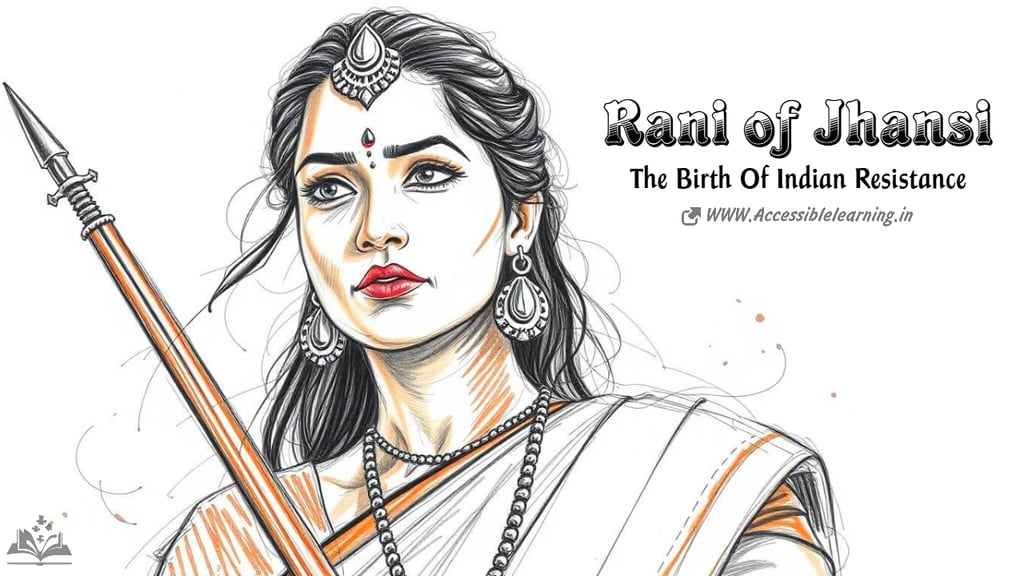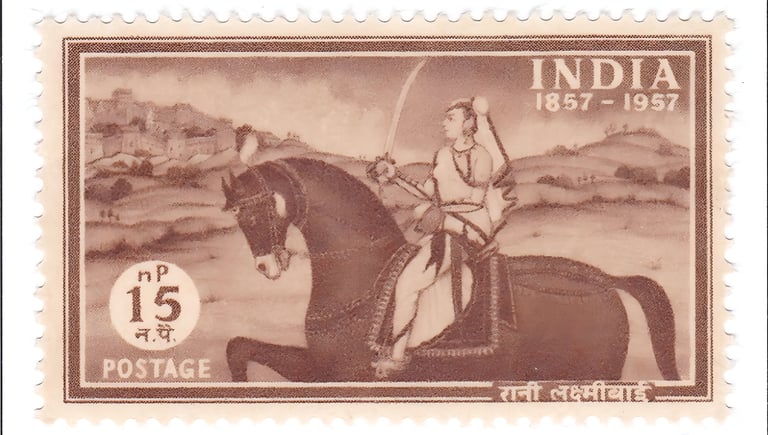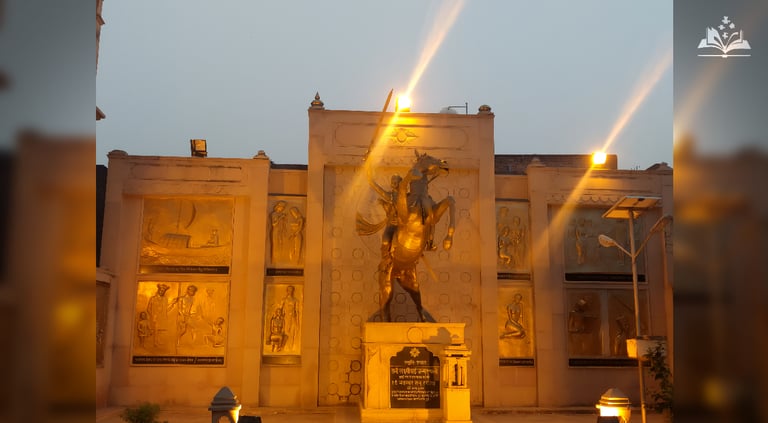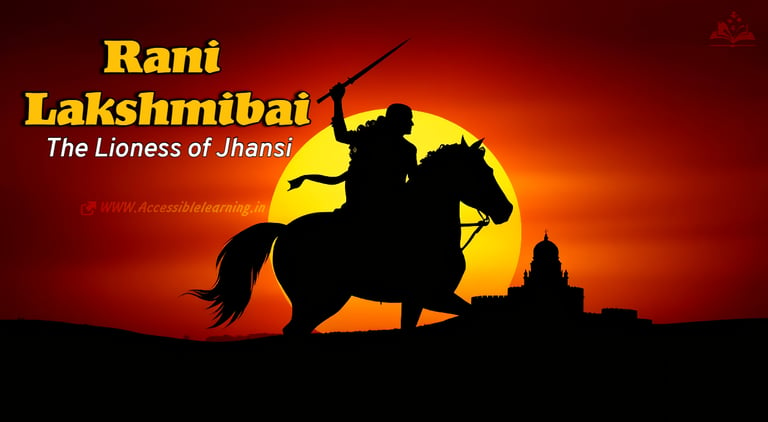
Rani Lakshmibai: The Lioness of Jhansi Who Defied an Empire
Discover the extraordinary life of Rani Lakshmibai, the legendary warrior queen of Jhansi who fought fearlessly against British colonial rule. Explore her remarkable journey of courage, leadership, and resistance that inspired a nation's fight for independence.
INDIAN HISTORYHISTORYINDIA/BHARATEDUCATION/KNOWLEDGE
Keshav Jha
3/30/20254 min read


Rani Lakshmibai Ji, also known as the Rani of Jhansi, stands as an iconic symbol of resistance, courage, and unwavering patriotism in Indian history. Her extraordinary life and heroic resistance against British colonial rule have immortalized her as one of the most celebrated freedom fighters of the 19th century.
Early Life and Background
Born as Manikarnika Tambe on 19 November 1828 in Varanasi, Uttar Pradesh, she was affectionately called "Manu" during her childhood. Raised in a Maratha Brahmin family, she received an exceptional education that was uncommon for girls of her time. Her father, Moropant Tambe, played a crucial role in shaping her fearless personality and providing her with comprehensive training in martial arts, horseback riding, and weaponry.
Marriage and Ascension to Throne
In 1842, she married Raja Gangadhar Rao, the ruler of Jhansi, and was subsequently named Rani Lakshmibai. After her husband's death in 1853 and the absence of a biological heir, the British East India Company invoked the Doctrine of Lapse—a controversial policy that allowed them to annex princely states without direct male succession.
Resistance Against British Colonial Rule
When the British attempted to seize Jhansi, Lakshmibai emerged as a formidable opponent. She famously declared, "Main apni Jhansi nahi doongi" (I shall not surrender my Jhansi), which became a rallying cry for resistance against colonial oppression.
Key Contributions During the 1857 Rebellion
During the Indian Rebellion of 1857, also known as the First War of Independence, Rani Lakshmibai played a pivotal role:
Military Leadership: She assembled and trained a robust army, including women soldiers, to combat British forces.
Strategic Warfare: Her military tactics and personal bravery inspired countless fighters to join the resistance movement.
Symbol of Rebellion: She became a powerful symbol of national pride and resistance against imperial rule.
Comprehensive Historical Context
Childhood and Early Influences
Manikarnika Tambe was born into a complex historical period of 19th-century India, characterized by significant political upheaval and increasing British colonial interference. Her birthplace, Varanasi, was a crucible of cultural and intellectual ferment, which profoundly shaped her early worldview.
Key developmental aspects of her childhood included
Exceptional educational opportunities uncommon for girls of her era
Extensive training in martial arts, including sword fighting and horseback riding
Exposure to progressive familial attitudes that encouraged female empowerment
Deep understanding of political complexities surrounding British colonial expansion
Family Background and Social Dynamics
The Tambe family belonged to the Maratha Brahmin community, a social group known for its intellectual prowess and historical resistance to external political domination. Her father, Moropant Tambe, was a court advisor who instilled in her a profound sense of political awareness and personal dignity.


Political Landscape of Mid-19th Century India
The British East India Company's Expansionist Policies
The period between 1840 and 1858 represented a critical juncture in Indian history. The British East India Company had systematically implemented aggressive territorial acquisition strategies, with the Doctrine of Lapse being a particularly controversial mechanism of imperial expansion.
Doctrine of Lapse: A Systematic Erosion of Princely Autonomy
This policy, introduced by Dalhousie in 1848, allowed the British to annex Indian princely states if:
The ruling monarch died without a natural heir
The state was deemed unable to govern effectively
The British deemed the ruling dynasty's governance unsatisfactory
Jhansi became a prime target of this exploitative policy, setting the stage for Rani Lakshmibai's remarkable resistance.
Military Strategy and Rebellion
Preparation for Resistance
Lakshmibai's military preparedness was extraordinarily sophisticated:
Military Training: She personally trained soldiers, including women, in combat techniques
Weapon Mastery: Exceptional skills in sword fighting and horseback riding
Strategic Planning: Developed sophisticated guerrilla warfare tactics
Diplomatic Negotiations: Attempted diplomatic channels before armed resistance
The 1857 Rebellion: A Turning Point
The Indian Rebellion of 1857 was more than a military confrontation; it was a comprehensive challenge to colonial legitimacy. Rani Lakshmibai emerged as a pivotal leader who transformed local resistance into a broader nationalist movement.
Psychological and Philosophical Dimensions
Leadership Philosophy
Unwavering commitment to territorial sovereignty
Rejection of colonial hierarchical structures
Belief in collective resistance
Emphasis on women's active political participation
Symbolic Significance
Female empowerment in a deeply patriarchal society
Resistance against systematic colonial oppression
Preservation of cultural and political autonomy


Detailed Account of Final Battle
The Battle of Gwalior on 17 June 1858 was not just a military engagement but a symbolic confrontation representing broader anti-colonial sentiments. Historical accounts suggest she fought with extraordinary valor, wearing male attire to continue fighting after being wounded.
Long-term Historical Impact
National and International Recognition
Inspiration for future independence movements
Symbol of anticolonial resistance globally
Representation of women's potential in leadership roles
Paradigm of courage and strategic thinking
Scholarly and Cultural Representations
Extensive academic research and cultural productions have continually reexamined and celebrated her life:
Numerous biographical works
Academic historical analyses
Theatrical and cinematic representations
Educational curriculum references
Cultural Impact
Numerous books, films, and artistic works have immortalized her heroic life. She remains a national icon, with monuments, postage stamps, and institutions named in her honor, celebrating her extraordinary contributions to India's freedom struggle.


Rani Lakshmibai represents more than a historical figure; she embodies the spirit of resistance, the power of individual conviction, and the potential for transformative leadership.
Her life narrative challenges simplistic historical narratives, presenting a complex portrait of resistance, strategy, and unwavering commitment to justice.
Enduring Legacy
Prototype of feminist leadership
Strategic military innovator
Symbol of anticolonial resistance
Inspiration for future generations
Historical Reflection: In the grand tapestry of human struggle against oppression, Rani Lakshmibai stands as a luminous thread, weaving together courage, intellect, and an unbreakable spirit of freedom.
Subscribe To Our Newsletter
All © Copyright reserved by Accessible-Learning Hub
| Terms & Conditions
Knowledge is power. Learn with Us. 📚


